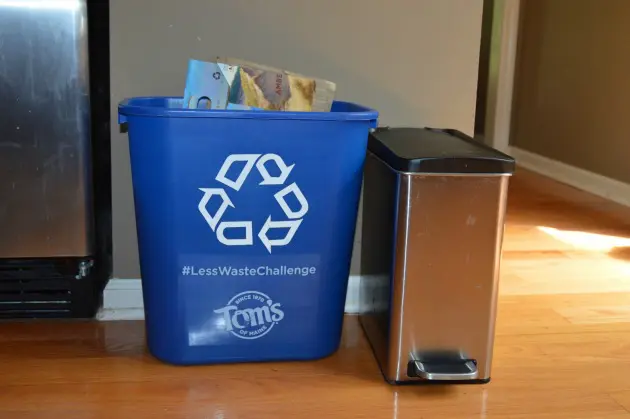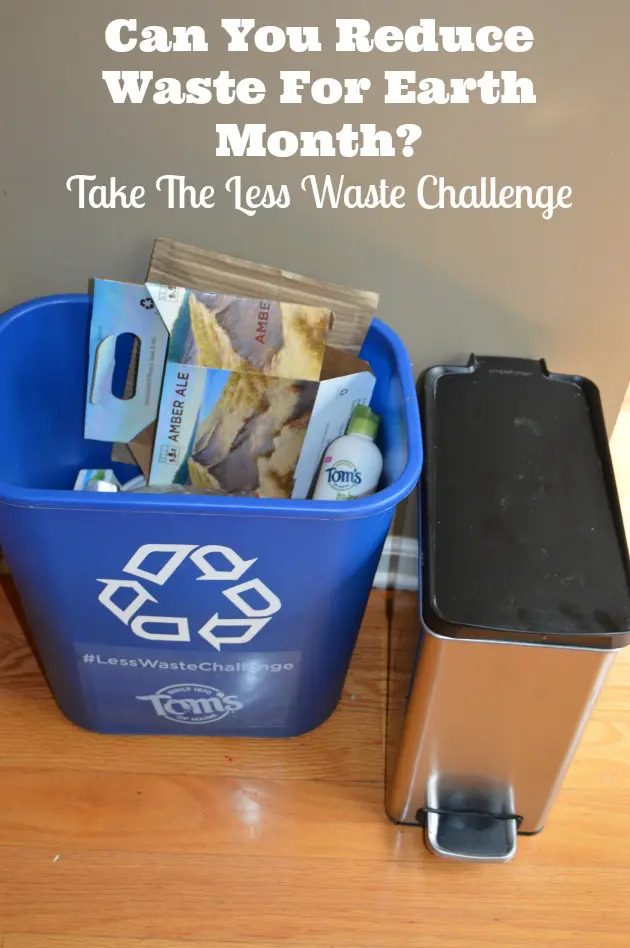With more and more people there comes more and more trash. We owe it to ourselves to start finding better ways. Here are 7 ways to reduce waste- it doesn’t have to be hard to reduce your waste with easy to implement tips like these! Once you have learned how to reduce your waste at home, you can try the Less Waste Challenge at the end of the post.
According to the EPA, more than 250 million tons of waste is generated every year in the United States and the average American family produces nearly 125 pounds of trash every week. Wow. That is staggering really. Imagine if you had to bury that 125 pounds of trash in your own back yard each week. You can quickly see how that would become a problem. Well, burying it out of site is no less of a problem. I think the first step towards successfully reducing household waste is having that realistic visual that gives you a real reason to create less waste. For me the visual of having to bury my own trash in my yard works wonders. Did you picture it? Are you motivated to learn ways to reduce waste?
How To Reduce Garbage Waste
The problem of waste is worldwide. But, there are local solutions. By making simple changes in your daily pattern of life, you and your family can affect much of the change that is deemed necessary to ensure that future generations will have a green earth, access to fresh water and good food, sustainable energy and a quality of life that makes it worth living. Reducing waste is a gradual process, so start with small changes and build from there. Every effort counts towards a more sustainable future. Here are several things you can do NOW to make a difference. These tips will help you minimize waste.
Reuse everything possible.
Think “eco-friendly craft supplies” before tossing paper products and glass containers in the trash. If you must toss, maintain recycle bins and separate by category. Teach your children about the different materials and enlist their help to sort and organize recyclables. If your city doesn’t pick up recycle bins, designate a Saturday and take things yourself to the recycle center.
Be an eco consumer.
Whenever possible, purchase recycled products rather than new. From building materials to notepads, many products had a previous life — flooring, countertop, carpet, glass bottles. Beyond the raw materials, many other items can be remade, repurposed or restored. Think renewal whenever possible. Make using these tips for reducing your waste fun! Enlist the children — they love creative projects. Make it a goal to furnish a playroom or a den with nothing new other than perhaps the television. You’ll be surprised how satisfying that can be.
Opt for simplicity.
Rely less on electronics and technology. You don’t have to eliminate modern convenience entirely, but instead of buying new books or downloading eBooks, videos and music, how about a family trip to the library where you can “check out” those items. Your budget will benefit, and so will you and your family. When interests change, check out something else. Just a thought.
Vow to give up disposable plastic.
As much as possible, eliminate disposable plastic from your life: Refuse plastic grocery bags by using your own fabric totes at the market. Eschew expensive bottled water in throwaway plastic bottles, instead filling your own reusable bottle with filtered tap water. Try to buy fresh, locally-produced food which is not encased in plastic containers or wraps. Use immediately for meals or store in reusable containers in your home.
Alter your eating habits.
The volume of food wasted is staggering, from what is lost between producer and market to what is scraped off the plate after a meal. By using meal planning, preparing from “scratch” and utilizing leftovers for other dishes, you can reduce household waste, better your health and teach your children good habits.
Channel past wisdom.
Generations past walked more, improvised more, made more of their own products at home and in the kitchen, lived more simply, wasted less and saved more money. You can make your own cleaning products, soaps, silver polish (does anyone even polish silver today?), pest sprays and remedies for simple ailments. And a whole lot of good food! Grow your own herbs and vegetables, can pickles, bake bread. Again, the children will be enthralled and there are lots of fun ways to get your children involved in the garden.
Conserve.
Conservation is not the same as recycling. But they are certainly related. In all things, try to lower your consumption — energy, gasoline, food — the health of the planet and its people may depend on it.
Take The Less Waste Challenge #LessWasteChallege
As you may know, I was a proud Tom’s of Maine Goodness Circle Member and I am happy to share with you the Tom’s Of Maine Less Waste Challenge. To encourage families to create less waste and to inspire future generations to make more sustainable choices, Tom’s of Maine and TerraCycle joined forces to launch the #LessWasteChallenge. Can you reduce waste? I took the challenge and I hope you do too!
Need a little inspiration?
For 45 years, Tom’s of Maine has been taking its own #LessWasteChallenge by developing natural personal care products with a focus on natural, responsible and sustainable practices and materials. Today, Tom’s of Maine has a goal of zero waste to landfills by 2020 at its manufacturing facility in Maine. Now that is impressive! I love hearing real stories like that because they make me think, if they can do it, so can I!
Now that you have reason to take the Less Waste Challenge, how does it work?
Commit To Take The Challenge
First, share on social media, “I ACCEPT THE #LESSWASTECHALLENGE”. The purpose of this is to get you commit and therefore make it a priority. The other purpose of this is to help the Less Challenge was spread so we can all be inspired by each other to reduce our waste at home. I love watching small efforts add up for large impacts.
Start Reducing Your Waste
In addition to the 7 ways to reduce trash above, you can also get really creative with reusing things. Here is a fun example in this short video:
Here are a couple of examples of how your actions to create less waste in your home make concrete differences:
- Chose disposable blades, not disposable razors= 2.3 pounds less waste.
- Use a cloth instead of paper towels= 45 pounds less waste.
So to start off, I made the commitment to waste less. I then shared the ideas for how to create less waste with my family. I watched fun videos with suggestions like this swap video.
Then, I printed out this little image below and my family is using it track our progress with hash marks for each item we put in the trash or recycling and also for each total bag of trash. It really works instantly! Believe me, you don’t want to be the one to hash mark next to bags of garbage going to landfills.
An extra little tip that my family uses is to have a tiny trash can and a large recycling bin. If you fill up the trash, you have to take it out to the big bin outside so you think if that item can be recycled or composted or upcycled before you toss it in the garbage.
Conclusion
Reducing waste is one of the most effective ways we can all contribute to a healthier planet and a better future. Simple habits like using a reusable water bottle, cloth napkins, and reusable bags instead of plastic bags can greatly cut down on unnecessary trash. Waste reduction also means paying attention to food waste by composting food scraps, which can be turned into new products instead of adding to landfills that release harmful greenhouse gases. By making these small but powerful choices, we can lower greenhouse gas emissions, fight climate change, and protect human health while creating a more sustainable lifestyle for everyone.
By making small changes to your lifestyle and utilizing these tips for reducing your waste , it is possible that the potentially devastating effects so graphically portrayed by the mountain can be reversed. Isn’t it worth the effort? We are happy to be reducing our household waste. Take the Less Waste Challenge and let us know how it goes in your house on social media @familyfocusblog!
Related Post:




Anne Campbell says
This is a great challenge. With a family of 5, we have a lot of trash. We are composting for the first time this year, which will reduce a lot of it. We don’t have curbside pick up for recycling, so it’s a bit more work to sort and haul everything off to the recycling center, but we are striving to do better at this in order to lessen our environmental impact.
Andrea says
I love Toms of Maine. It is the only toothpaste I use for my family. I think encouraging people to waste less is such an important topic. Thanks for sharing!
Plamen @ The Happy House Cleaning says
Some tips to reduce your organic waste:
1. Save your bread ends in a bread bag in the freezer. Keep adding to them. When you have enough, you have free bread crumbs, croutons, or stuffing bread.
2. If you’re poaching chicken, use the opportunity to make chicken stock at the same time by adding some roughly chopped onions, celery, and carrots, and some herbs. Homemade stock tastes better and is much cheaper. Plus, you can control the salt content. (Save your shrimp shells and fish bones for seafood stock, and beef bones and scraps for beef stock.)
3. Propagate your veggie scraps: leeks, scallions, celery, onions will all regrow from their roots.
4. Save your veggie seeds.
5. Don’t toss moldy cheese; just cut away the moldy bits. The rest is perfectly good.
6. The crumbs at the bottom of the tortilla chip bag? Crush them and store them in a mason jar. They make a deliciously crunchy bread crumb coating. Same for potato chips, which are really good on fish fillets.